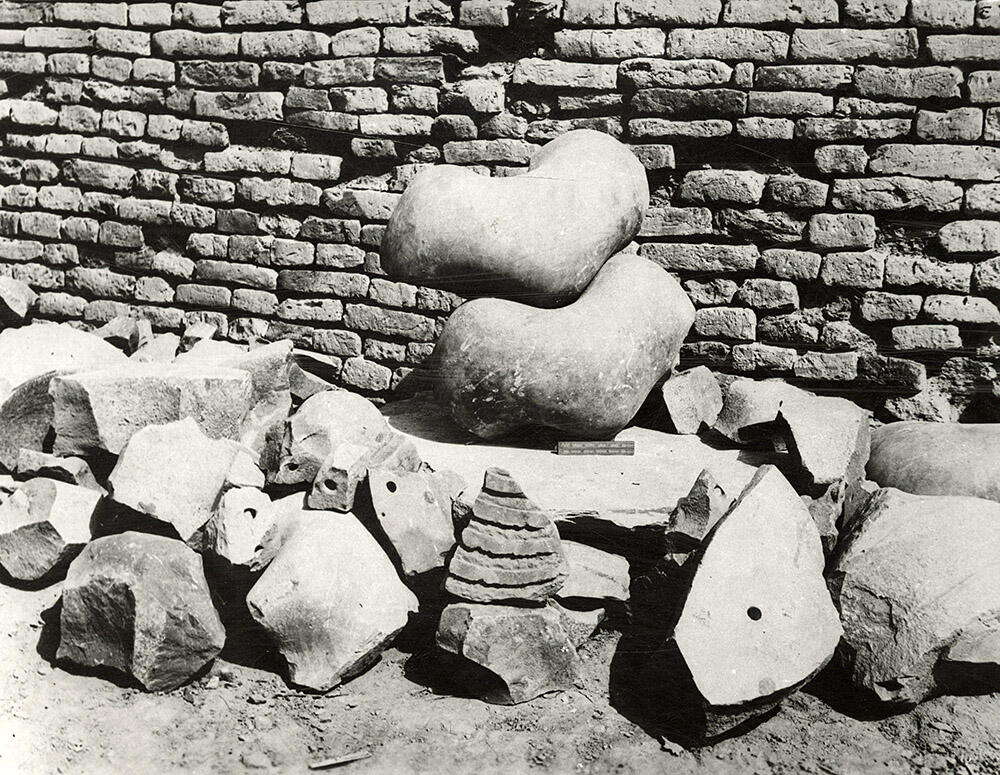Mound A-B
"The next three strata were devoid of any structural remains though the lowest of them was packed with a large number of undulating stone rings of the same character as those described by General Cunningham. What purpose they served remains a mystery."
- Daya Ram Sahni, 1926. Annual Report Of The Archaeological Survey Of India 1923-24, pg 53. No corresponding image.
"Very little is left of the IVth stratum. The next stratum below revealed in squares P 18/2 and 7, a solidly built niche at a depth of 24 ft. below the summit of the mound. It measures 8 ft. 4 in. by 5 ft, 2 in. externally, and is composed of bricks of the usual size, viz, 11 x 5 1/2 x 2 1/2 in. Later, it was repaired with larger bricks measuring 14 x 7 x 3 1/2 in. On its paved floor Mr. Sahni found a broken medium-sized earthenware jar, a number of goblets with pointed bases, numerous potsherds and charcoal. Some bones were also found in these vessels. Special interest, however, attaches to a number of fragments1 mostly of undulating grey stone rings of different sizes, arc-shaped pieces of red standstone with raised flat bands in parallel curves (PI. LXXXIIl, 33 and 35), and some objects of yellow limestone, which were found to the north and north-east of the above-mentioned niche. To the east of these finds were recovered some more red sandstone objects of smaller size with shapes suggestive of round lingams (Pl. LXXXIll, 26 and 27), oblong shafts rectangular in section (PI. LXXXIII, 29) blocks finished on three faces (PI. LXXXIII, 31), and other non-descript pieces of stone. Some interesting pieces from among them are given in the list of finds below.
From this same spot probably came two large undulating rings of yellow Jaisalmer stone, and a disc of grey stone which are now lying near the tomb of Naugaza (PL CXVII, 1, 2 and 16). Each of the rings is 2 ft. in diameter, 1 ft. 1 1/2 in, in height and pierced through the centre with a hole 10 1/2 in. in diameter. The disc, with a diameter of 2 ft. 9 in, is finished on the face and contiguous edge which tapers out for 3 inches. These three stone objects were also known to Sir Alexander Cunningham who mentions the local legend that two of them were the thumb rings, and the large disc, the 'nag', or gem of the ring2 of the Naugaza notwithstanding that the so-called gem is larger than the ring. The Rai Baliadur recovered one undulating ring of yellow stone from the village (PI. CXVII, 6) and a round one of dull grey stone with a yellowish band (diam, 1 ft. 8 in,, and diam. of hole 10 in.) at the centre from the Harappa Police Station (PI. CXVII, 3). Unlike the former, the latter has no undulations at the top or bottom. It is similar to a large collection of stone rings found by Rai Bahadur Daya Ram Sahni in Room 49, House V, Block 2 of Section B of the Hr. Area at Mohenjo-daro.3 These large stone rings and many of the miniature ones, fashioned out of stone, shell, faience, and imitation carnelian, are undoubtedly cult-objects, as shown by Sir John Marshall, probably symbolizing the Yoni or female principle.4
1. Some of these are inscribed with a number of lines which may be pictographic, cf. Pl.CIII, 54-57.↩
2. C.S.R., Vol. V, p. 109, Pl. XXXIII, 8 and 9.↩
3. Cf. M.I.C., p.191, and also Pl. XXXVIII, f, which shows a row of limestone rings found in chamber 74, Block 3, L. Area.↩
4. Ibid. pp. 64-66.↩
- Madho Sarup Vats, Excavations at Harappa: Being an account of archaeological excavations at Harappa carried out between the years 1920-21 and 1933-34. Volume I - Text; Volume II - 139 Plates., pg 139-40. Image Pl. LXXXIII, 26, 27, 29, 31, 33, 35; Pl. CXVII, 1, 2, 3, 6, 16.
Note: There are some further details of these rings in Vats' report (pg 140-141), but this photograph is not reproduced in that report.
This collection of stone objects includes two large wavy ringstones that are still located in an area outside of the tomb of the saint, Baba Noor Shah. They are sitting on top a circular stone piece that is said to have been set in a ring worn by the saint. The stone became large when someone tried to steal it. The other broken pieces were found in the excavations of Trench B.
- Jonathan Mark Kenoyer, 2023.
[Original caption] Fragments of stone rings and other architectural fragments

